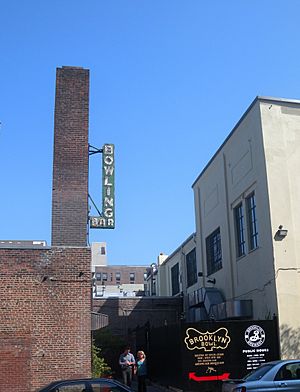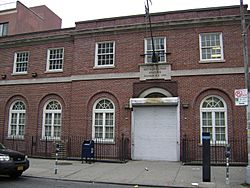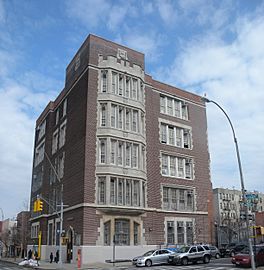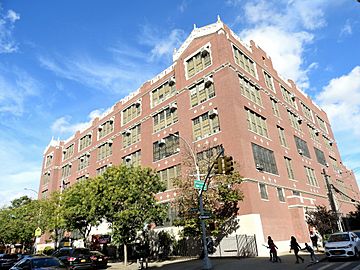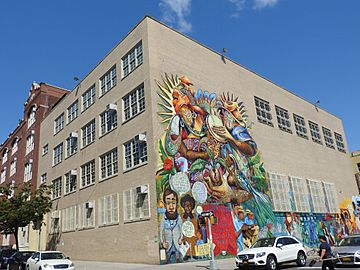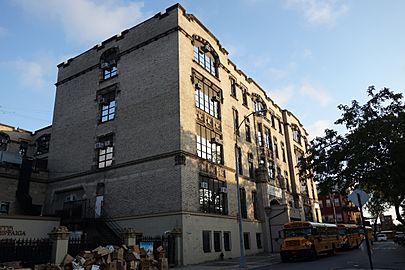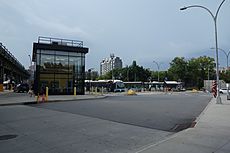Williamsburg, Brooklyn facts for kids
Quick facts for kids
Williamsburg
|
|
|---|---|
|
Neighborhood
|
|
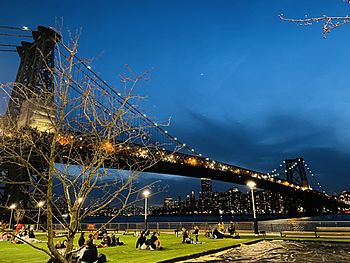
|
|
| Nickname(s):
The WillieB, The Burg, Billyburg
|
|
| Country | |
| State | |
| City | New York City |
| Borough | Brooklyn |
| Community District | Brooklyn 1 Brooklyn 3 |
| Named for | Jonathan Williams |
| Area | |
| • Total | 5.64 km2 (2.179 sq mi) |
| Population
(2010)
|
|
| • Total | 151,308 |
| • Density | 26,811/km2 (69,439/sq mi) |
| Race/Ethnicity | |
| • White | 66.5% |
| • Hispanic | 26.3% |
| • Asian | 2.9% |
| • Black | 2.8% |
| • Other | 2.4% |
| Economics | |
| • Median income | $98,284 |
| ZIP Codes |
11206, 11211, 11249
|
| Area code | 718, 347, 929, and 917 |
Williamsburg is a lively neighborhood in Brooklyn, a borough of New York City. It is surrounded by other neighborhoods like Greenpoint to the north and Bedford-Stuyvesant to the south. To its west is the East River.
Williamsburg used to be its own city until 1855, when it became part of Brooklyn. Its name was originally spelled "Williamsburgh" with an "h," but this was changed to "Williamsburg" later.
For many years, especially near the water, Williamsburg was a busy industrial area. Factories made many products. However, in the mid-1900s, many jobs moved away. The area then faced tough economic times.
Later, local groups worked to improve housing, schools, and the community. Artists and creative people also moved in during the 1980s and 1990s. They used old warehouses for art and music, making the neighborhood a vibrant place. Small, local businesses also started to grow again.
In the 2000s, the city made changes that brought in more tall buildings and big chain stores. This caused the cost of living to go up. Even though some original artists moved out, Williamsburg still has a lively contemporary art scene and fun nightlife. It is known around the world as a creative and exciting place. In the early 2000s, it became a hub for indie rock and electroclash music.
Williamsburg is home to many different groups of people. These include Italians, Jews, Hispanics, Poles, Puerto Ricans, and Dominicans.
Williamsburg is part of Brooklyn Community Board 1. Its main ZIP Codes are 11206, 11211, and 11249. The New York City Police Department patrols the area. As of 2020, about 151,308 people live in Williamsburg.
Contents
History of Williamsburg
How Williamsburg Started
In 1638, the Dutch West India Company bought land in this area from the Lenape Native Americans. In 1661, the Dutch created the town of Boswijck, which included the land that would become Williamsburg. When the English took over in 1664, the town's name became Bushwick.
For about 140 years, people called this part of Bushwick "Bushwick Shore." It was separated from other villages by creeks and swampy land. Farmers from other parts of Bushwick brought their goods to Bushwick Shore. From there, they would take a ferry across the East River to Manhattan to sell their products.
In 1802, a land investor named Richard M. Woodhull bought 13 acres of land. He asked Colonel Jonathan Williams to survey the property. Woodhull named the area Williamsburgh (with an "h" at the end) in his honor. Williamsburgh grew quickly and became its own independent city. The first mayor was Abraham J. Berry. In 1855, the "h" was removed from the name.
Becoming a Village and City
Williamsburg officially became the Village of Williamsburgh within the Town of Bushwick on April 14, 1827. Within two years, it had a fire company, a post office, and over 1,000 residents.
The deep waters of the East River made Williamsburg a good place for factories. Many industrialists, especially from Germany, built shipyards here. Raw materials came in by ship, and finished products left directly from the docks. Sugar refineries and breweries were also important industries. One famous sugar refinery was Domino Sugar.
On April 18, 1835, the Village of Williamsburg grew by taking in more land from Bushwick. The Village was divided into three areas: the "South Side," the "North Side," and the "New Village." Today, "North Side" and "South Side" are still used. The "New Village" became home to many German immigrants and was sometimes called "Dutchtown."
By 1845, Williamsburgh had 11,500 people. On April 7, 1840, it separated from Bushwick and became the Town of Williamsburg. Edmund Smith Driggs was the first president of the Village of Williamsburg in 1850. Driggs Avenue is named after him.
In 1851, Williamsburg became the City of Williamsburgh. It was divided into three wards. The "h" was dropped from the name in 1855.
Joining Brooklyn and New York City
In 1855, the City of Williamsburg and the Town of Bushwick became part of the City of Brooklyn. This area was called the "Eastern District."
During this time, Williamsburg grew a lot in industry, culture, and economy. Rich New Yorkers built large homes along the shore. Famous companies like Standard Oil and Pfizer Pharmaceutical had roots here. Many factories for food and household products, like Domino Sugar, were built. Today, many of these old factory buildings have been turned into homes.
The population was first mostly German. After the Williamsburg Bridge opened in 1903, many Jewish people from Manhattan's Lower East Side moved to Williamsburg. The neighborhood also had important banks, like the Williamsburgh Savings Bank. Eastern District High School, one of Brooklyn's early high schools, opened here in 1900.
In 1898, Brooklyn became one of the five boroughs of New York City. The Williamsburg Bridge, completed in 1903, connected Williamsburg even more closely to Manhattan. This bridge helped thousands of immigrants and second-generation Americans move from crowded Manhattan to Williamsburg. Williamsburg soon became one of the most crowded neighborhoods in New York City. The famous novel A Tree Grows in Brooklyn tells the story of a young girl growing up in Williamsburg during this time.
After World War II, many people from Europe, including Hasidic Jews who survived the the Holocaust, came to Brooklyn. The area south of Division Avenue became home to a large group of Satmar Hasidic Jews from Hungary and Romania. Hispanic people from Puerto Rico and the Dominican Republic also began to settle in Williamsburg.
Changes and New Buildings
Since the 2000s, the price of land in Williamsburg has gone up a lot. The North Side, near the New York City Subway lines, is often more expensive. This has also caused rents to rise in the South Side.
In 2005, the New York City Council changed the rules for building along the waterfront in North Williamsburg and Greenpoint. This allowed many new tall residential buildings to be built. The city also offered tax breaks to developers. This changed the area from a place with many small businesses and creative spaces to one with more high-rise buildings and chain stores.
Many old warehouses that were used for art and community events were turned into expensive apartments. For example, the former Gretsch music instrument factory became luxury lofts. These changes brought new residents to the area.
Land Use in Williamsburg
Williamsburg has different types of areas for buildings. These include areas for factories, stores, homes, and mixed-use buildings (which have both homes and businesses). North Williamsburg has mostly light factories and medium-sized apartment buildings. Along the waterfront, there are also tall residential buildings with shops, and some remaining heavy industries. The area around Broadway is mainly for stores and offices. South Williamsburg has mostly medium to tall residential buildings, with some shops on the ground floors.
Important Buildings and Landmarks
Many buildings in Williamsburg are protected as city landmarks by the New York City Landmarks Preservation Commission.
The Kings County Savings Bank building, built in 1860, is a beautiful example of French architecture. It is on the National Register of Historic Places and was made a New York City landmark in 1966.
The Williamsburg Houses are a group of 20 four-story buildings. They were built in 1938 and were the first large public housing project in Brooklyn. They became a city landmark in 2003.
In 2007, three buildings of the Domino Sugar Refinery were also named New York City Landmarks. The original refinery was built in 1856. A fire in 1882 led to the brick and stone buildings we see today. The refinery stopped working in 2004. Now, there are plans to turn the site into homes and businesses.
The New England Congregational Church and Rectory, built in 1852–1853, is also a city landmark. It is now a Pentecostal church.
Williamsburg also has a historic district called the Fillmore Place Historic District. It has several buildings in the Italianate style and was landmarked in 2009.
Other important buildings on the National Register of Historic Places include the Austin, Nichols and Company Warehouse, built in 1915, which is now apartments. The German Evangelical Lutheran St. John's Church (1883), Public School 71K (1888–1889), and the United States Post Office (1936) are also listed.
Culture in Williamsburg
Williamsburg has many different communities. "South Williamsburg" is mainly home to Hasidic Jews and a large Puerto Rican population. North of this area is "Los Sures," which has many Puerto Ricans and Dominicans. Further north is the "North Side," which has traditionally been home to Polish and Italian families. East Williamsburg has many industrial areas and is home to Italian American, African American, and Hispanic communities.
Because Williamsburg is close to Manhattan, it has become popular with new residents. Bedford Avenue and its subway station are often seen as the center of this new wave of people.
Different Communities
Hasidic Jewish Community
Williamsburg is home to thousands of Hasidic Jews from different groups. It is also the main center for one part of the Satmar Hasidic group. About 57,000 Satmar Jews live in Williamsburg.
Hasidic Jews first moved to Williamsburg before World War II. Many came to escape difficult living conditions in Manhattan. After the late 1940s, many Holocaust survivors, especially Hasidic Jews from Hungary and Romania, settled here. They were led by various Hasidic leaders, including the rebbes of Satmar and Klausenberg. The Satmar Rebbe, Rabbi Joel Teitelbaum, became very influential in the community.
The Hasidic community in Williamsburg has a very high birthrate, with families often having many children. This means the community is growing quickly. Many Jewish organizations help residents with housing and other needs.
Italian-American Community
A large part of the Italian community on the North Side came from the city of Nola in Italy. Every summer, people from Nola celebrate the "Festa dei Gigli" (feast of lilies) to honor St. Paulinus of Nola. Immigrants brought this tradition to Williamsburg.
For two weeks each summer, the streets around Our Lady of Mount Carmel church are filled with celebrations of Italian culture. The main event is "Giglio Sundays," when a 100-foot-tall statue, with a band and singer, is carried through the streets. This is done to honor St. Paulinus and Our Lady of Mount Carmel.
Many Italian-Americans still live in the area. The northeastern part of Williamsburg, known as "Italian Williamsburg," has many Italian-American families, community centers, and restaurants. Parts of Graham Avenue are even called Via Vespucci, honoring Amerigo Vespucci and the neighborhood's Italian heritage. Even if people move away, many return each summer for the feast.
Puerto Rican and Dominican Community
On Williamsburg's Southside, also called "Los Sures" in Spanish, there is a large Puerto Rican and Dominican population. Puerto Ricans started coming in the 1940s and 1950s, often for jobs at the Brooklyn Navy Yard. Dominicans arrived in the 1970s and 1980s. Today, about 27% of the neighborhood's population is Hispanic or Latino.
Graham Avenue, between Grand Street and Broadway, is known as the "Avenue of Puerto Rico." Havemeyer Street has many Hispanic-owned bodegas (small shops) and barber shops. The Latino community has several cultural places, like the Caribbean Social Club and the "El Puente" Community Center. The Moore Street Market, also called La Marqueta de Williamsburg, is a popular market.
There are also cultural events, like Puerto Rican Heritage and Dominican Independence Day celebrations. "El Museo De Los Sures" is a museum about the Southside's history. Williamsburg also has two campuses of Boricua College. A place popular with Dominican-Americans is the Fula Lounge, where Merengue and Raggaeton artists perform. Once a year, Williamsburg and Bushwick host a Puerto Rican Day parade.
Many famous Latino people grew up in Williamsburg, including TV chef Daisy Martinez and U.S. representative Nydia Velazquez.
Arts Community
Visual Arts and Creative Culture
Artists began moving to Williamsburg in the 1970s because rents were low and there was plenty of space. This trend grew in the 1990s. A group of artists called the Brooklyn Immersionists started to combine art and music in the streets, on rooftops, and in old warehouses near the waterfront. Their work was featured in many art magazines and news stories.
By 1996, about 3,000 artists lived in Williamsburg. The area had many art galleries and performance spaces, like Sideshow Gallery and Galapagos Art Space. Local magazines like wagmag and 11211 Magazine covered the arts scene.
Music Scene
Williamsburg has become a well-known place for live music and new bands. In the late 1980s and 1990s, many music and theater venues opened in old industrial buildings. A new culture grew around the Bedford Avenue subway station. These venues attracted artists and musicians for late-night music and performances.
One of the first big gatherings of artists and musicians was a three-day festival in 1990 at Epoché, a warehouse space. Other events followed, combining live music, dancing, and art. These events were part of the "Brooklyn Immersionists" movement.
Over time, as more chain stores and tall buildings came to the area, and rents increased, many of these smaller venues closed. However, new, smaller spaces opened. In the summers, concerts and performances are held at the Williamsburg waterfront.
Williamsburg is also known for its funk, soul, and worldbeat music, with labels like Daptone and bands like Antibalas Afrobeat Orchestra. Jazz and World Music can be found at places like Zebulon. A Latin Jazz community also thrives among the Caribbean residents in Southside. In the early 2000s, Williamsburg was a center for electroclash music.
Theatre and Cinema
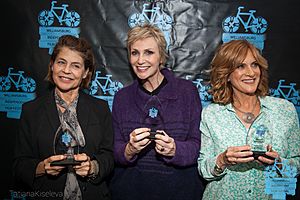
In the 1990s, many experimental theater groups and media groups started in Williamsburg. They performed in public spaces and old buildings. Galapagos Art Space, which opened in 1996, hosted many performances.
Today, Williamsburg has indie theater spaces like the Brick Theater. The Williamsburg Independent Film Festival started in 2010. The neighborhood also has a movie theater called Williamsburg Cinemas, which opened in 2012.
Changes in the Neighborhood
Low rents were a big reason artists first moved to Williamsburg. However, this changed a lot after the late 1990s. The city started to change zoning rules to allow larger buildings. This led to higher rents.
Average monthly rents in Williamsburg can be quite high. This has caused many artists and creative people to move to other neighborhoods like Bushwick and Bedford-Stuyvesant, where rents might be lower. In 2011, the United States Postal Service (USPS) even split the 11211 zip code because of a "large increase in population and in the number of companies doing business in our area."
Demographics of Williamsburg
For counting purposes, Williamsburg is divided into two main areas: Williamsburg and North Side/South Side. In 2010, the total population of these areas was 78,700, which was an 8% increase from 2000.
The population was made up of 66.5% White people, 26.3% Hispanic or Latino people, 2.9% Asian people, and 2.8% African American people.
The entire Community Board 1, which includes Greenpoint and Williamsburg, had 199,190 residents in 2018. The average life expectancy in this area is 81.1 years. Most people living here are middle-aged adults and young people.
In 2016, the average household income in Community Board 1 was $76,608. In 2018, about 17% of residents lived in poverty, which is a bit lower than the average for all of Brooklyn and New York City. Also, fewer people were unemployed compared to the rest of the city. About 48% of residents have trouble paying their rent.
Recent census data from 2020 shows that both North and South Williamsburg have a large number of White residents (30,000 to 39,999). The North section also has 10,000 to 19,999 Hispanic residents.
Fire Safety
The New York City Fire Department (FDNY) has four fire stations in Williamsburg to keep the community safe:
- Engine Company 211/Ladder Company 119 – 26 Hooper Street
- Engine Company 216/Ladder Company 108/Battalion 35 – 187 Union Avenue
- Engine Company 221/Ladder Company 104 – 161 South 2nd Street
- Engine Company 229/Ladder Company 146 – 75 Richardson Street
- Engine Company 209/Ladder Company 102/Battalion 34 – 850 Bedford Avenue
Post Offices and ZIP Codes
Williamsburg uses three ZIP Codes: 11211 for most of the neighborhood, 11206 for the southeastern part, and 11249 for the far western part along the East River. The United States Postal Service has two post offices in Williamsburg: the Williamsburg Station at 263 South 4th Street and the Metropolitan Station at 47 Debevoise Street.
Education in Williamsburg
Williamsburg generally has more residents with a college education than other parts of New York City. About half of the population (50%) has a college degree or higher.
Students in Greenpoint and Williamsburg have been improving in reading and math. Reading achievement went from 35% in 2000 to 40% in 2011. Math achievement went from 29% to 50% in the same period.
The number of elementary school students who miss a lot of school days is a bit higher than the city average. However, 77% of high school students in Greenpoint and Williamsburg graduate on time, which is higher than the city average of 75%.
Schools in the Neighborhood
The New York City Department of Education runs public schools in District 14. Here are some of the public elementary schools (grades PK-5) in Williamsburg:
- PS 16 Leonard Dunkly
- PS 17 Henry D. Woodworth
- PS 18 Edward Bush
- PS 84 Jose de Diego (grades PK-8)
- PS 132 Conselyea
- PS 147 Isaac Remsen
- PS 196 Ten Eyck
- PS 250 George H. Lindsay
- PS 257 John F. Hylan
- PS 319 Walter Nowinski
- PS 380 John Wayne Elementary
Public middle and high schools include Brooklyn Latin School (a special high school for grades 9–12) and IS 318 Eugenio Maria De Hostos (grades 6–8). The Grand Street Campus has several high schools, including the High School of Enterprise, Business, & Technology. The Harry Van Arsdale Educational Complex houses three small high schools. The Young Women's Leadership School of Brooklyn helps girls develop leadership skills. There are also bilingual public schools, offering Spanish-English, French-English, and Yiddish-English programs.
Other schools in Williamsburg include El Puente Academy for Peace and Justice and the Ethical Community Charter School. Success Academy Williamsburg and Williamsburg Collegiate Charter School are public charter schools. Williamsburg Northside Schools offer programs for infants, toddlers, and preschoolers.
Libraries
The Brooklyn Public Library (BPL) has two branches in Williamsburg. The Williamsburgh branch at 240 Division Avenue is one of Brooklyn's largest library buildings and is a New York City designated landmark. The Leonard branch at 81 Devoe Street opened in 1908. It has a tribute to Betty Smith, the author of A Tree Grows in Brooklyn, whose main character loved visiting the library.
Transportation in Williamsburg
Williamsburg is served by several New York City Subway lines. These include the BMT Canarsie Line (L train), the BMT Jamaica Line (J, M, and Z train), and the IND Crosstown Line (G train).
The Williamsburg Bridge connects the neighborhood to the Lower East Side in Manhattan. The Brooklyn–Queens Expressway also runs through Williamsburg.
Many bus routes, including the B24, B32, B39, B44, B44 SBS, B46, B60, Q54, Q59, end at the Williamsburg Bridge / Washington Plaza. Other bus lines like the B43, B48, B57, B62, B67, B110 also serve the area.
Since 2017, the NYC Ferry's East River route has two stops in Williamsburg. This ferry connects Williamsburg to Manhattan and other parts of Brooklyn and Queens.
There are also plans to build the Brooklyn–Queens Connector (BQX), a light rail system that would run along the waterfront. This project is still being planned.
Parks and Open Spaces
Williamsburg has several parks and open spaces where people can relax and enjoy the outdoors:
- Bushwick Inlet Park
- Cooper Park
- Domino Park
- East River Park (Marsha P. Johnson State Park)
- Grand Ferry Park
- McCarren Park
- Northside Piers
- Williamsburg Waterfront
Environmental Concerns
A local community group called El Puente has described Williamsburg as having environmental challenges.
Bushwick Inlet Park Site
National Grid is working to clean up pollution at a former gas plant site in Williamsburg, located at Kent Avenue between North 11th and North 12th Streets. This cleanup is happening so the site can be turned into Bushwick Inlet Park.
There are also ten old oil storage tanks at the site of Bushwick Inlet Park. A plan from 2016, called "Maker Park," suggested turning these tanks into attractions like a theater and hanging gardens. However, the city said the tanks are very polluted and need to be cleaned before the area can become a park.
Notable Residents
- Persis Foster Eames Albee (1836–1914) – the first "Avon Lady."
- Red Auerbach (1917–2006) – a famous basketball coach.
- Joy Behar (born 1942) – comedian and co-host of The View.
- Mel Brooks (born 1926) – a well-known comedian.
- Steve Burns (born 1973) – former host of Blue's Clues.
- Alexa Chung (born 1983) – English model and TV presenter.
- Peter Criss (born 1945) – drummer for the band Kiss.
- Dane DeHaan (born 1986) – actor.
- Alan Dershowitz (born 1938) – a famous lawyer.
- Peter Dinklage (born 1969) – actor.
- Will Eisner – a famous comic artist.
- Su Friedrich (born 1954) – filmmaker and professor.
- Peaches Geldof (1989–2014) – British model and socialite.
- Oscar Isaac (born 1979) – film and stage actor.
- David Karp (born 1986) – creator of Tumblr.
- Zoë Kravitz (born 1988) – actress.
- James Lafferty (born 1985) – actor and director.
- Leonard Lopate (born 1940) – public radio talk show host.
- Sid Luckman (1916–1998) – NFL Hall of Fame football player.
- Barry Manilow (born 1943) – songwriter and performer.
- Henry Miller (1891–1980) – novelist.
- Man Ray – a famous artist.
- Buddy Rich (1917–1987) – a famous drummer.
- Winona Ryder – actress.
- Mikheil Saakashvili – former president of Georgia.
- Gene Simmons – member of the band Kiss.
- Betty Smith (1896–1972) – author of A Tree Grows in Brooklyn.
- Jerry Stiller (1927–2020) – comedian and actor.
- Alex Turner (born 1986) – English musician from Arctic Monkeys.
- Michael K. Williams (1966–2021) – film and television actor.
Religious Leaders
- Zecharia Dershowitz (1859–1921) – founded one of the first Yiddish communities in America.
- Yom-Tov Ehrlich (1914–1990) – a famous Hasidic musician.
- Yosef Greenwald (1903–1984) – a leader of the Pupa Hasidic dynasty.
- Mordechai Hager (1922–2018) – a leader of the Vizhnitz Hasidic sect.
- Yekusiel Yehudah Halberstam (1905–1994) – founder of the Sanz-Klausenburg Hasidic dynasty.
- Joel Teitelbaum (1887–1979) – founder and first Grand Rebbe of the Satmar Hasidic dynasty.
- Moshe Teitelbaum (1914–2006) – a world leader of the Satmar Hasidim.
- Aaron Teitelbaum (born 1947) – one of the current Grand Rebbes of Satmar.
- Zalman Leib Teitelbaum (born 1951) – one of the current Grand Rebbes of Satmar.
See also
 In Spanish: Williamsburg (Brooklyn) para niños
In Spanish: Williamsburg (Brooklyn) para niños





